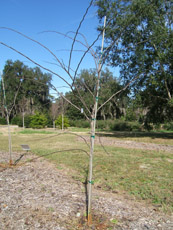Cercis canadensis 'Forest Pansy' (Red Leaf Redbud)

*Click on picture for more images of this species.
- USDA Hardiness Zone: 6A - 8B
- Mature Height: 20 to 30 ft
- Mature Spread: 15 to 25 ft
- Growth Rate: Fast
- Availability: Somewhat available
- Drought Tolerance: High
- Salt Tolerance: Poor
- Light Requirements: Full sun to partial shade
- Native Origin: Native to North America.
- Soil Drainage: Tolerates well-drained sites to occasionally wet sites.
- Foliage: Deciduous tree with showy fall color.
- Flowers: Pink to lavender, very showy flowers in spring.
- Pests: The main insect pests are treehoppers, scale and webworm. The main diseases are canker, leaf spots and verticillium wilt.
Description: Red Leaf Redbud is a moderate to rapid-grower, 20 to 30 feet in height, which has red twigs and beautiful, shimmering, purple/red new leaves, which fade to purple/green during the summer in its southern range. The veins on the backs of the leaves are a deep maroon and make a striking contrast with the light gray/green leaf. The splendid, purple/ pink flowers appear all over the tree in spring, just before the leaves emerge. Red Leaf Redbud has an irregular growth habit when young but forms a graceful, flat-topped, vase shape as it gets older.
The tree usually branches low on the trunk, and if left intact forms a graceful multi trunked habit. Be sure to avoid weak forks by pruning to reduce the size of the lateral branches and save those which form `U'-shaped crotches, not a `V'-shaped crotch. Keep them less than half the diameter of the main trunk to prevent branch splitting. This will increase the longevity of the tree. Yellow (although somewhat variable and unreliable) fall color and tolerance to partial shade make this a suitable, attractive tree for understory or specimen planting. Low branching habit makes it ideal for specimen, deck or patio planting, and it is especially suited for planting on 15-foot-centers on both sides of an entry walk or driveway. Best not used as a street tree due to low disease resistance and short life, it is nice in commercial and residential landscapes, or as an accent in a shrubbery border.
Red Leaf Redbuds grow well in full sun in the northern part of its range but will benefit from some shade in the southern zones, particularly where summers are hot. The best growth occurs in a light, rich, moist soil but Red Leaf Redbud adapts well to a variety of soils, including sandy, clay or alkaline. Trees look better when they receive some irrigation in summer dry spells, particularly if the tree is planted in an area where the roots are confined. Young trees survive best when transplanted in the spring or fall but containerized trees can be planted anytime. Red Leaf Redbud fixes its own nitrogen, so only light (if any) nitrogen fertilizer is recommended. The beans provide food for some birds. `Forest Pansy' may be less adapted to drought than the species.
Gainesville Observations: Trees were planted from containers; all survived. Red foliage color is not retained throughout the entire summer. It begins fading to green in early to mid summer. But it sure presents a very different tree until that time.

